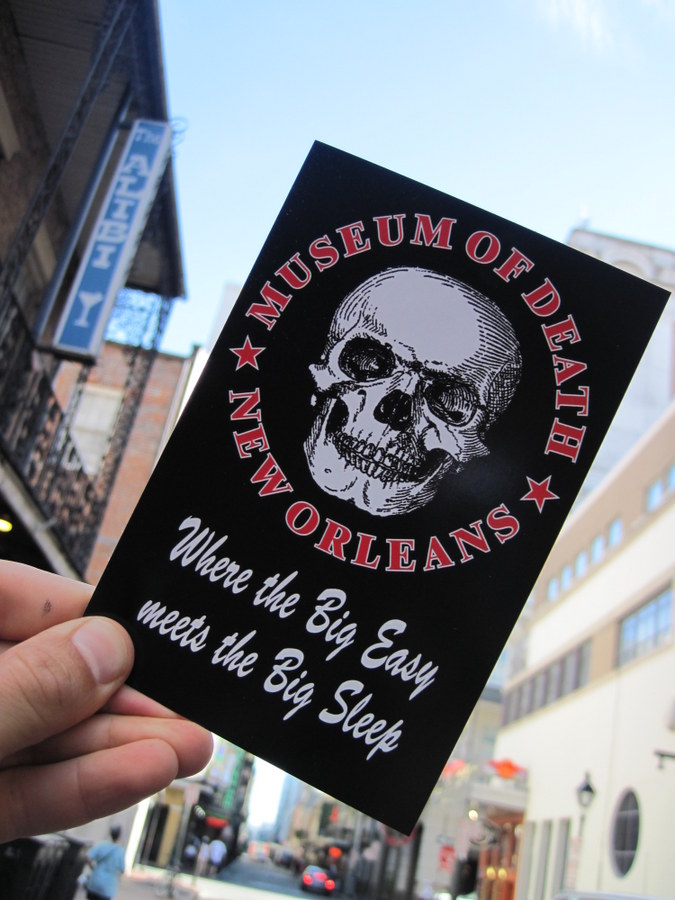

“This city has the voodoo and the vampires, and that’s cool, but there’s a lot of hokey shit,” said New Orleans Museum of Death manager Scott Healy. “The difference between this and all that other stuff is this is the real deal.” (Photo by Justin Nobel)
Speaking from behind the welcome counter, on which sits a tall jar of teeth, a sheep skull and a photo of a dismembered human being who has been flung from a motorcycle and scraped across the highway leaving a trail of blood and organs, Scott Healy, manager of the newly opened Museum of Death—227 Dauphine Street—explains to me why downtown New Orleans needs another death-themed attraction.
“This city has the voodoo and the vampires, and that’s cool, but there’s a lot of hokey shit,” says Healy. “The difference between this and all that other stuff is this is the real deal.”
Healy’s brother JD co-launched the museum’s tremendously successful mothership, the Hollywood Museum of Death in 1995. The New Orleans museum’s website indicates the following exhibits:
I stroll down to 227 Dauphine to see for myself. “The front of the exhibit does start you off small and not upsetting at all,” one Yelp reviewer aptly notes: Taxidermal butterflies, squirrels, mice, cicadas, fish, and the compulsory tiny jars packed with pig fetuses. Beyond, death takes on a more human note. On a table below a series of paintings done by John Wayne Gacy, who worked the 1970s kids’ birthday party scene as a clown called Pogo—and molested and murdered at least 33 Chicagoland young men and boys—are strewn grotesque crime scene photos. One stands out: A 1950s-looking businessman slouched beside a toilet with his head down and shirt smothered in blood—presumably, he shot himself in the head.
There is a cache of Manson Family photos, and a separate room on cannibalism, fit with shrunken heads, a log detailing infamous cannibal Jeffrey Dahmer’s daily life in Milwaukee County Prison, and a rolling video about the Uruguayan rugby team whose plane crashed in the Andes in 1972. Of the 45 people aboard, 16 survived.
“We had to make a tough decision,” one survivor recounts in the video. “We cannot eat metal, rock, or ice; the only thing we have is the dead bodies of our friends.”
In an adjacent room is a vivid documentary on 9/11, and death suddenly becomes more personal. It is hard not to get sucked in, but I pull myself away to check out what surely is the museum’s horrendous main event: the Theatre of Death.
In a red theater with plush red pews screens a continual loop of catastrophic death, to symphony music. The score and décor do not jive with the film, which is the point. What naturally happens is that one becomes dreamy and placid as the excruciating scenes unfold: Police officers huddle around a flipped-over car in a frozen field, using primitive tools to scrape free the mangled body; a detective reaches into a puddle leaking from a corpse and scoops a sticky red glob into a sample bag; a motorcycle rider sails off a jump, bounces awkwardly off the safety net and careens down to the ground, landing on his head. In the theater’s bathroom, painted sanitarium white, there’s one final horror, which I shan’t even mention.
The museum isn’t so much about death but the tragic and terrible ways in which a human being can die. The overarching sensation evoked is one of vulnerability and absurdity, that we are all just squishy bags of blood and guts who can be split open at any moment by a bullet, a speeding car, or anything really. The museum is torturous and obscene and, therefore, seemingly a success.
But considering how much death lurks on the streets just outside the doorstep, it also seems a bit tactless. At times the entire city, minus the bouncy tourists with their daiquiris, can feel like a city of the walking dead, or half-dead, or slowly dying, or swiftly dying. Just the other day, I met a young woman painting pictures on the street who, within the last two years, had lost her husband to alcohol, a neighbor to suicide, and a friend to an overdose. Last year, the man who lived in an apartment below us died alone, firefighters had to break down the door. And recently, a man who lived on our street hung himself from a tree. The 2015 murder count—and remember, New Orleans is a city of less than 400,000 people—is presently 132. Death is everywhere in this city.
Anyway, if you want to go far beyond the ghost tours and voodoo shops, into a realm that is truly horrific, walk in the door at 227 Dauphine.
“Feels good to be alive?” Healy asks one group, as they exit the museum and enter the bright sunshine and raucous noise of the French Quarter. Um, yes, sort of.
The New Orleans Museum of Death is open daily 10am-6pm, and closed on Tuesdays. Visit them online here: http://www.museumofdeath.net
Follow Digital Dying on Facebook, and author Justin Nobel on Twitter
The most famous coroner on earth may well be Dr. Thomas Tsunetomi Noguchi, who was…
The day after Halloween, and the day after that, is Day of the Dead, and…
Following on his recent posts regarding deaths by extreme heat, Justin Nobel shares his thoughts…
Few parts of the country have been spared from July's soaring temperatures. In fact, July…
Deep inside a South African cave called Rising Star, scientists have made an incredible discovery—a…
Last week, in Nakano City, Japan, an evacuation center was opened in the gymnasium of…